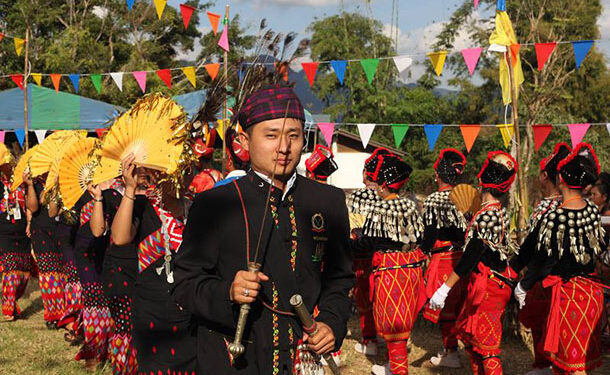Despite the objection of thousands of members of the Kachin public, the ethnic minority group’s state government has vowed to go ahead with plans to include the famed Manau dance at Kachin State Day celebrations in Myitkyina, the state capital, early next year.
The state’s chief minister said at a meeting with Kachin youths in Myitkyina earlier this month that the government would proceed with plans to include the traditional dance in commemoration of Kachin State Day on Jan. 10.
Those remarks came in defiance of the expressed wishes of more than 8,000 Kachin State residents who had signed a petition by November, voicing opposition to the proposal.
Tu Raw, an executive committee member of the Kachin Traditional Literature and Cultural Committee, said petitioners felt it was “not the appropriate time” to bring back the formerly annual dance tradition, which has been absent in the state for the last three war-torn years.
The last time Kachin dancers performed the Manau was in early 2011. About six months later, a 17-year ceasefire agreement between the Burma Army and the Kachin Independence Army (KIA) broke down and open war resumed. The two sides have been trading fire and casualties intermittently ever since.
In August, the state government announced plans to bring the Manau dance tradition back for the Jan. 5-11, 2015, celebration of Kachin State Day. By November, however, a petition against the proposal had garnered more than 8,000 signatures.
“It is not that we, all the Kachin public, agree to the inclusion of the Manau dance during the State Day celebration, as the authorities have claimed,” said Tu Raw. “We are not against [celebrating] Kachin State Day, we just think it [including the Manau dance] is not right amid its people facing homeless and insecurity.”
The Burma Army’s Nov. 19 attack on a KIA military academy, which caused 23 deaths and injured 20 others, has only added to sentiment that the Manau dance should not be performed in January, he said.
On Nov. 25, Kachin State’s Minister of Border Security Col. Than Aung told The Irrawaddy that that the Burma Army would provide additional security for the festival. The petition was sent to the state government three days later, on Nov. 28, according to Tu Raw, who added that many of the Kachin sub-tribes’ representatives on the Manau dance organizing committee had left it in a boycott against the plan.
In the years leading up to its cancelation following the resumption of hostilities in June 2011, the Kachin Traditional Literature and Culture Committee had led the Manau festival.
The Manau dance can be performed year-round to celebrate accomplishments or other special occasions, but traditionally takes place in its fullest splendor during Kachin State Day, which has been celebrated since 1948. A remnant of animistic beliefs that is still practiced today by the now largely Christian Kachin, the Manau spectacle features hundreds of traditionally attired, sword-wielding Kachin whose march-like dancing holds a colorful assemblage of “Manau poles” as its focal point.
Though both the KIA and Burma Army have lost scores of soldiers over the last three years, it is Kachin State’s civilian populations that have endured the brunt of the hardship stemming from the conflict. About 100,000 civilians remain in camps for internally displaced persons (IDPs), where conditions are poor and inhabitants are largely dependent on humanitarian supplies from overstretched aid groups, a somber reality that those in opposition have cited as reason to abstain from Manau festivities again in 2015.
But Hkyet Hting Nan, an Upper House lawmaker and chairman of the Unity and Democracy Party of Kachin State, said the iconic Manau dance was one of three critical components to Kachin State Day festivities.
“Despite opponents, the Kachin State Day celebration will be a greater success with the inclusion of the Manau dance, modern songs and sporting activities,” said the ethnic Kachin lawmaker, who served as the Manau festival’s lead organizer from 2005 to 2008.

















